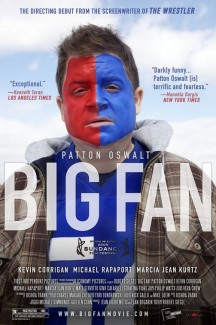Big Fan (Robert D. Siegel, 2009): USA
Reviewed by Richard Feilden. Viewed as part of the 2009 Los Angeles Film Festival.
 Big Fan‘s Paul Aufiero (Patton Oswalt) has the “never meet your heroes” trope hammered home when a misunderstanding turns a chance encounter with his idol into a trip to the hospital. The film certainly isn’t as tumultuous a fall from grace for writer/director Robert D. Siegel (the screenwriter behind last year’s critical smash The Wrestler) as it is for his protagonist, but it suffers from its misjudged attempts to inject comedic moments into a harsh reality, as well as a second act which just seems to be waiting for the third to arrive.
Big Fan‘s Paul Aufiero (Patton Oswalt) has the “never meet your heroes” trope hammered home when a misunderstanding turns a chance encounter with his idol into a trip to the hospital. The film certainly isn’t as tumultuous a fall from grace for writer/director Robert D. Siegel (the screenwriter behind last year’s critical smash The Wrestler) as it is for his protagonist, but it suffers from its misjudged attempts to inject comedic moments into a harsh reality, as well as a second act which just seems to be waiting for the third to arrive.
Paul’s life is going nowhere, and he doesn’t seem to care, as long as his team is winning. He is a thirty-five year old man who spends his nights working as a garage attendant. While cooped up in his tiny booth, he lovingly prepares the spontaneous phone rants which he unleashes on a sports talk-radio show. There, under the cover of anonymity and his bed-sheets, he does battle with his nemesis, Philadelphia Phil (Michael Rapaport). The airwaves sizzle with their invective and chest-beating, only occasionally interrupted by Paul’s mother banging on his bedroom wall and screaming at him to keep the noise down. Then one night, while driving around with his best friend, he spots his hero, Giant’s player Quantrell Bishop (Jonathan Hamm) at a gas station. He follows him to a night-club where, after finally summoning up the courage to approach his hero’s entourage, an innocent comment earns him a savage beating at the hands of the very man whose exploits he celebrates every night. When the police get involved, Paul is left with a terrible choice; should he bring this thug to justice, or say nothing for the good of the team?
Starting with the good, Patton Oswalt is brilliantly cast as Paul in this film. He turns the man-child from someone who could have so easily been a caricature and source of derision into a person with whom anyone who has a hobby or an interest can sympathize. His life may be essentially meaningless, but to him it has purpose, and Oswalt lets us see that. He is aided in this by the direction from Siegel, who adds an element of sexual tension to Paul’s ‘relationship’ with Bishop, from the lingering shots of the player’s sweat-soaked physique immortalized on a poster above Paul’s bed, to the gyrating groins of the lap dancers that Paul is oblivious to as he gazes upon his hero in the flesh. We may not share Paul’s obsession, but the film helps us to understand it.
Unfortunately the film has an uneven tone which detracts from the story. Utilizing Oswalt’s undeniable comedic talents, the film swings from hilarity to tragedy too often, leaving the viewer disoriented. This isn’t helped by the overly long middle section in which Paul battles with his freak-show family (his brother is a lawyer who prostitutes his services in terrible TV advertisements in which he promises accident compensation, his sister-in-law a woman whose artificial chest seems to contain her brains–it’s certainly big enough) over whether or not to sue the man who landed him with potentially life-altering injuries. Their constant attempts to change his mind just keep repeating themselves as we wait for Paul to take control of his life back.
So, the film is a mixed result. I can certainly recommend the lead performance, but I can’t recommend the film in which it finds itself. It may be that Siegel will give us truly great work again, but I suspect that it will be as a screenwriter, with another creative force reining him in from the director’s chair.
About this entry
You’re currently reading “Big Fan (Robert D. Siegel, 2009): USA,” an entry on Student Film Reviews
- Published:
- 07.01.09 / 10am
- Category:
- Films, Los Angeles Film Festival 2009
3 Comments
Jump to comment form | comments rss [?] | trackback uri [?]